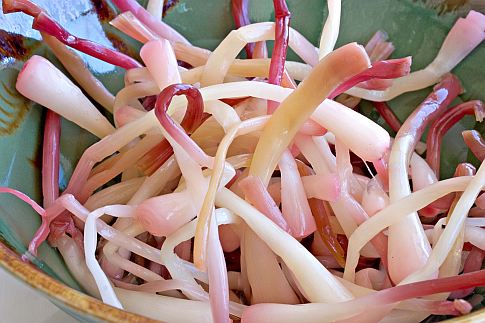How to make quick pickles
The subtle science of brine and crunch (recipe included).

In almost any pantry, pickles are a staple. A wide variety of fruits and vegetables are preserved using salt and acid, although the classic cucumber has become ubiquitous enough to earn the simple default name of “pickle.” Pickling is a preservation technique that dates back to ancient history. Every culture has its own version of the pickle, ranging from Mexico’s pickled jalapeno pepper to Korea’s kimchi. Pickles are often used as a flavor accent, garnishing a meal rather than acting as the main focus. Many times they are included because their high acid content is considered beneficial for the body. For example, in Japan, pickled ginger is served alongside raw fish as much for its digestive and anti-microbial properties as it is for the taste.
Fruits and vegetables are commonly pickled either in a brine, like dill pickles, or packed in sugar and salt mixtures known as cures, like lime pickles. Traditional pickles are made by initiating an anaerobic fermentation process. During fermentation the sugars are transformed into lactic acids by Lactobacillus plantarum. The lactic acid gives pickles their characteristic tang, while also creating an inhospitable environment for bad bacteria by eliminating sugars and creating an acidic setting. (Quick pickles do not undergo the process of fermentation. They are simply acidified in a brine or cure over a short period of time.)
Salt acts as a preservative during this process by encouraging the growth of Lactobacillus plantarum, the good bacteria. The concentration levels are important: at too high a concentration, the Lactobacillus plantarum cannot thrive, and at concentrations that are too low, less beneficial bacteria, such as Leuconostoc mesenteroides, have an advantage and produce negative results in the final product. Although optimal concentrations vary for different fruits and vegetables, a 5 percent salt solution as the base for your brine is a good rule of thumb. Salt is also important because it draws the moisture from the fruits and vegetables being pickled, which adds to the brine and transforms the texture of the finished product.
Oxygen encourages the negative bacteria, and so it’s important to keep it away from your developing pickles until fermentation is complete. Acid is important because it helps prevent the growth of botulinum bacteria. The last important factor for encouraging good bacteria and proper fermentation is temperature. Optimum pickling temperatures fall in the range between 18 and 20 degrees Celsius (64 to 68 degrees Fahrenheit).
Here are a couple of tips for making pickles at home. Make sure that you use uniformly sized pieces of fruits or vegetables. Wash them before cutting to remove any microorganisms on the skin. Weigh your ingredients and follow a recipe; the proportions are very important for a safe fermentation process. Use canning or pickling salt, because the anti-caking ingredients in table salt will cloud your brine. Use soft or filtered water, because iron and sulfur will darken your pickles, and calcium in tap water can interfere with the fermentation process. Use whole spices to infuse flavor. Avoid eating any soft or slippery pickles in the finished product, as these are signs of improper fermentation.
In our kitchen we tend to rely on the quick pickling process. It’s a wonderful way to utilize the abundance of produce available at different times of the year in a safe and delicious manner. We’ve included our recipe for pickled ramps to get you started.
Pickled ramp bulbs
Ingredients
- 1000 grams cleaned ramp bulbs
- 250 grams rice vinegar
- 230 grams salted yuzu juice (available in Asian markets)
- 150 grams honey
- 40 juniper berries
Recipe
Mix the vinegar, yuzu juice, honey, and juniper berries together until the honey is dissolved. Divide the ramps between two large vacuum bags. Pour half of the pickling solution into each bag and then vacuum seal on high pressure. Refrigerate the ramps for at least an hour, and preferably overnight. Alternatively, you can bring the brine to a boil and pour it over the ramps. Once they have cooled place them in a tightly sealed container and let them rest in the refrigerator for three days before using.
The ramps will mature over the next several days. Kept fully submerged in their liquid in a sealed container under refrigeration, they will last for a couple of weeks. Use the ramps with roasted fish, grilled steak or even in a martini. The juice from the ramps can be used to make wonderful vinaigrettes.